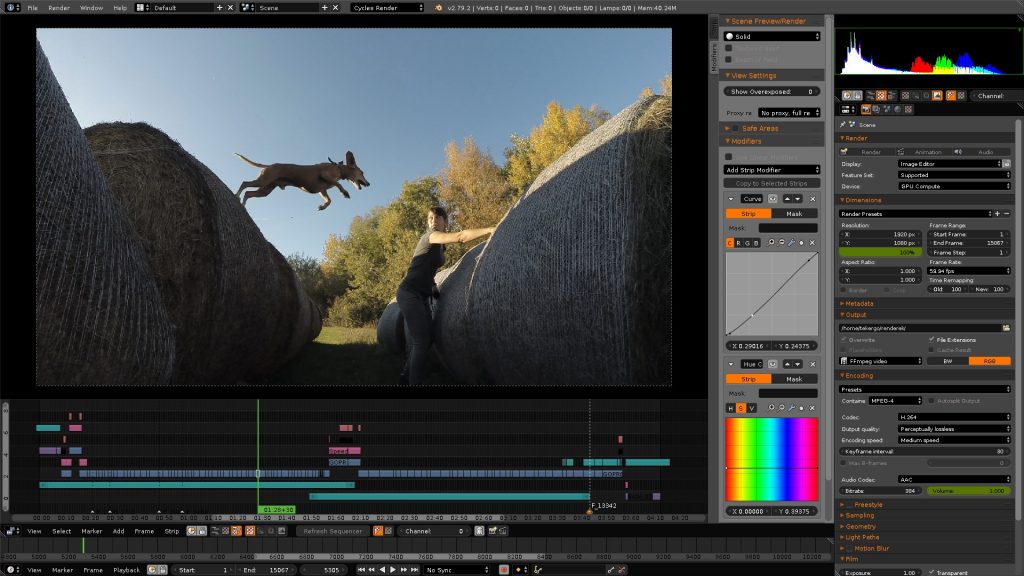

- BLENDER VIDEO EDITOR HOW TO
- BLENDER VIDEO EDITOR MOVIE
- BLENDER VIDEO EDITOR 720P
- BLENDER VIDEO EDITOR FREE
To save drive space and hang onto as much resolution as we can from the footage, we can resize this either with Quicktime 7 or a video editing program to a proper HD resolution of 1280×720 at 30fps.

It is also horizontally compressed (a mistake probably, as you can see above) as the dimensions are 1280 by 1080 which mixes two standard HD formats – 1280×720 OR 1920×1080, not both. The green screen shot was single frames (a common way to work with uncompressed footage), so to make that easy to handle you have to make it into a video. (Resizing videos, making videos out of image sequences and sliding large images to make pans are outside the scope of this article, but we will return to these techniques at another time.) How you do this is not relevant to the tutorial.
BLENDER VIDEO EDITOR 720P
We need to end up with two videos of 720p at 30fps. We need to make the assets we are using a common size so they fit together in the composite.

The background plate (because we needed to fake a pan across a city skyline) is a really high-resolution panoramic shot of Singapore by Erwin Soo from Wikipedia.
BLENDER VIDEO EDITOR FREE
Our green screen shots in this instance came from the excellent free green screen library at Hollywood Camerawork. Uncompressed shots make for better composites, but for the purposes of a demo, we’ll take what we can get. They tend to be professionally shot which is a boon but are usually compressed which is not. There are plenty of examples around the web of shots you can play with. Then you have the background plate which is the bit you want to show through the green bits of the foreground, making the whole thing look as though the background and foreground were filmed at the same time. You have the foreground plate and the green screen bit with an actor filmed in front of a green screen.
BLENDER VIDEO EDITOR MOVIE
Obviously, to get the best green screen composites you have to shoot good “plates.” “Plates” are the main bits of the shot that you bolt together in movie visual effects.
BLENDER VIDEO EDITOR HOW TO
You can shift between two effect strip settings by selecting an initial time in the project, adjusting the effects, and then pressing I while the effect is still selected to create a keyframe.In this article we give you an introduction to node-based compositing and show you how to do a basic green screen composite shot with Blender. These effects can combine with transitions to create amazing visual shifts. You can apply a visual effect to an asset in Strip > Compositing > Blend.You can adjust the saturation of an asset or multiply its colors in Strip > Color.You can adjust an asset to only display every Nth frame in Strip > Video > Strobe.You can change the position, size, rotation, or center of an asset in Strip > Transform.You can adjust the opacity of an asset in a higher channel to add a tint or overlay in Strip > Compositing.This is important because you can use effect strips to overlay your videos in interesting ways. To start, it’s crucial to note that your video and audio is overlaid-and tracks in a higher channel will appear over tracks in a lower channel. Once you have the basic keyboard shortcuts for Blender’s video editor memorized, learning some of the advanced editing tricks is a fairly simple process. Alternatively, you can adjust the settings for your selected asset by clicking through Image > Apply. Videos will automatically stretch to fit the project resolution when they are added to the sequencer, so you may need to adjust the resolution of specific assets to remove any distortion. You can even remove a segment of video by cutting it, selecting it, and pressing X.Īfter you’ve finished editing your video, you will need to make a few adjustments to the settings in the Scene panel. Alternatively, you can drag one of the edges of a clip while holding G to trim it. Once you have video strips in the sequencer, you can cut and arrange them into smaller segments by selecting them on the sequencer and pressing K after aligning the playhead (or selection line) where you would like to cut the video. If you prefer, you can also use your operating system’s built-in file explorer to drag and drop assets into Blender. You will be able to drag and drop any files you like from the file manager into the sequencer. Keeping all of your files in one folder will allow you to access them easily from the file manager. Ideally, you should store all of your assets in one parent folder.


 0 kommentar(er)
0 kommentar(er)
